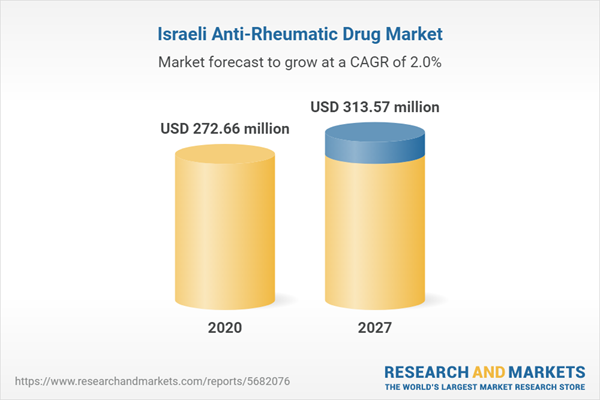The Israel antirheumatic drug market was valued at US$272.657 million in 2020. The market is projected to grow at a CAGR of 2.03% to attain a value of US$313.567 million by 2027. The market in Israel is poised to show decent growth over the course of the next five years due to rapid growth in private healthcare spending in the country, which is further anticipated to drive the demand for numerous treatments, medical services, and medicines, among others. According to data by the Israel Central Bureau of Statistics, the proportion of private spending reached 40%, thus indicating a rise in the demand for better healthcare services, which would also lead to an increase in the demand for more advanced treatments and testing procedures, which is anticipated to positively impact the growth of the market throughout the forecast period. Furthermore, universal healthcare is provided by the Israeli government to the entire population of the country, which also spends more than 7% of the country's GDP on healthcare.
Additionally, the continuously growing geriatric population in the country is also one of the key drivers for the antirheumatic drug market growth in Israel during the next five years. The geriatric population of the country reached around 11.997% by the year 2018 from 10.147% during the year 2008. Old people suffer from various types of diseases that include chronic back pain, joint pain, and other inflammatory disorders, which is anticipated to significantly drive the demand for numerous types of drugs in the country and further add up to the market growth.
The Israel antirheumatic drug market has been segmented on the basis of the type of disease, type of molecule, and sales channel. On the basis of the type of disease, the market has been classified into osteoarthritis, rheumatoid arthritis, gout, lupus, and others. The market has been segmented based on molecule type; the market has been segmented based on pharmaceuticals and biopharmaceuticals. By the sales channel, the segmentation has been done on the basis of prescription and over-the-counter (OTC).
Additionally, the continuously growing geriatric population in the country is also one of the key drivers for the antirheumatic drug market growth in Israel during the next five years. The geriatric population of the country reached around 11.997% by the year 2018 from 10.147% during the year 2008. Old people suffer from various types of diseases that include chronic back pain, joint pain, and other inflammatory disorders, which is anticipated to significantly drive the demand for numerous types of drugs in the country and further add up to the market growth.
The Israel antirheumatic drug market has been segmented on the basis of the type of disease, type of molecule, and sales channel. On the basis of the type of disease, the market has been classified into osteoarthritis, rheumatoid arthritis, gout, lupus, and others. The market has been segmented based on molecule type; the market has been segmented based on pharmaceuticals and biopharmaceuticals. By the sales channel, the segmentation has been done on the basis of prescription and over-the-counter (OTC).
Key Developments in the Market:
- In February 2020, Can-Fite, an Isreal-based biopharmaceutical firm, announced that approximately half of the 525 patients anticipated for its Phase III ACRobatTM trial to examine its drug candidate Piclidenoson as a first-line treatment for rheumatoid arthritis had been enrolled. The implementation of an interim analysis is being overseen and supervised by an independent data monitoring committee (IDMC), which will have unrestricted access to the data.
COVID-19 Insights:
COVID-19 had a significant impact on Israel's antirheumatic drug market. The region's drug demand is being driven by the rising number of adolescents and adults suffering from various rheumatic disorders. However, due to the closure of numerous industrial facilities as a result of the epidemic and the deployment of stringent measures like lockdown and social distancing, productivity was decreased. Border controls also had a significant impact on regional imports and exports as well, disrupting the supply chain. The aforementioned factors slowed down the market slightly.Segmentation
By Type of Disease
- Osteoarthritis
- Rheumatoid Arthritis
- Gout
- Lupus
By Drug Class
- Disease-modifying Anti-Rheumatic Drugs (DMARDs)
- Nonsteroidal Anti-inflammatory Drugs (NSAIDs)
- Corticosteroids
- JAK inhibitor
By Sales Channel
- Prescription
- Over-The-Counter (OTC)
Table of Contents
1. INTRODUCTION
2. RESEARCH METHODOLOGY
3. EXECUTIVE SUMMARY
4. MARKET DYNAMICS
5. ISRAEL ANTI-RHEUMATIC DRUG MARKET ANALYSIS, BY TYPE OF DISEASE
6. ISRAEL ANTI-RHEUMATIC DRUG MARKET ANALYSIS, DRUG CLASS
7. ISRAEL ANTI-RHEUMATIC DRUG MARKET ANALYSIS, BY SALES CHANNEL
8. COMPETITIVE ENVIRONMENT and ANALYSIS
9. COMPANY PROFILES
Companies Mentioned
- AbbVie Inc.
- Amget Inc.
- Johnson and Johnson
- Pfizer Inc.
- GlaxoSmithKline plc
- Merck & Co., Inc.
- Eli Lilly and Company
- Novartis AG
- Celgene Corporation (Bristol-Myers Squibb)
- Eisai Co., Ltd.
Methodology

LOADING...
Table Information
| Report Attribute | Details |
|---|---|
| No. of Pages | 76 |
| Published | September 2022 |
| Forecast Period | 2020 - 2027 |
| Estimated Market Value ( USD | $ 272.66 million |
| Forecasted Market Value ( USD | $ 313.57 million |
| Compound Annual Growth Rate | 2.0% |
| Regions Covered | Israel |
| No. of Companies Mentioned | 10 |









